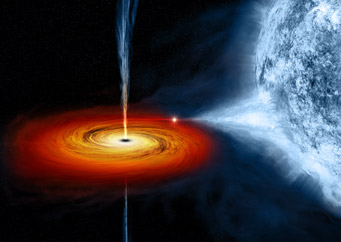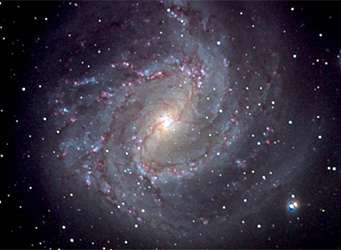Stellar-mass black holes could affect their environments more than astronomers thought.
A black hole in the spiral galaxy M83 might have bitten more off than it should be able to chew. Black holes theoretically adhere to what’s called the Eddington limit, which declares that an accreting black hole can only spew out so much energy in jets, winds, and radiation from its fluffy disk. Above the limit, all that outward-pushing radiation cuts off the flow of infalling gas and starves the beast, damping down said spewing.

An artist's highly symbolic representation of a stellar-mass black hole siphoning material off its massive companion star. The hot inner accretion disk emits X-rays that astronomers can use to estimate the black hole's mass.
NASA / CXC / M.Weiss
Black holes occasionally seem to violate this limit, but only for short periods of time.
But as Roberto Soria (Curtin University, Australia) and colleagues reported February 27th in Science, one star-orbiting black hole 15 million light-years away looks like it broke its limit for roughly 20,000 years.
The team studied the binary system, called MQ1, in X-rays, optical, infrared, and radio using some of the best ground- and space-based telescopes around. The X-rays come from the black hole’s accretion disk, and based on how emission from the disk should look for a given mass, the team used the system’s brightness in X-rays to estimate how hefty the black hole is.
The astronomers then turned their attention to what looks like a bubble around MQ1, ostensibly inflated by the black hole’s jets and other outflows. Based on the emission from the shock-heated gas inside the bubble, they calculated how much energy was dumped into the gas and, therefore, the average jet power needed to do it.
Finally, they used the estimated jet power, the bubble’s estimated size, and the gas’s presumed density to calculate how long the structure had been expanding (and, therefore, how old it is).
Put together, these three lines of investigation suggest that the black hole is between about 10 and 115 solar masses, with a best guess of just over 40. Over the course of about 20,000 years, it vomited on the order of 1052 ergs in energy into its surrounding environment, 10 times more than a typical supernova would.

The galaxy M83 has well-defined spiral arms that trace regions of active star formation. Astronomers have detected a stellar-mass black hole near the galaxy's nucleus that erupted in more energy than would be expected.
Adam Block / NOAO / AURA / NSF
If the black hole is really about 40 solar masses, the energy output is a few times above its Eddington limit. The problem grows worse for lower masses.
Astronomers have observed a few sources on par with MQ1 in terms of output power (including a different, transient system Soria's team also found in M83), but the detection of X-rays from the accretion disk itself makes this system a unique opportunity to study the black hole’s mass.
And the mass is the key uncertainty in this picture. If the black hole is at the higher end of the mass range (or a little higher), that might smooth over the problem. Unfortunately, due to distance and observational constraints it’s next to impossible to directly measure this black hole’s mass, Soria says.
Joey Neilsen (Boston University) says that for him, the puzzle is less that the black hole appears to have once been super-Eddington — it’s currently not — than that the object broke the limit for so long. Stellar-mass black holes in binary systems often “turn on” for several months or a year, spitting out jets, and then fade away for maybe a decade or more. If MQ1 operated in bursts it would mean that, in order to average out to a super-Eddington level over those several thousand years, the outburst “chunks” would have had to have been even more energetic.
Soria says that it should be possible for a black hole to go three to four times above its Eddington rate for up to 100,000 years if a huge amount of dense, opaque gas is dumped onto the black hole from a massive companion star. Normally, the photons produced inside the infalling, hot gas build up so much radiation that the pressure can shut off the infall. But if the gas is very dense and opaque to radiation, the photons’ escape is delayed — sometimes they don’t even have time to emerge before the gas surrounding them crosses the event horizon (with them still inside). In this case, the photons can’t “do their duty of pushing gas away,” he says. He suspects that’s what happened with MQ1.
On the other hand, if the black hole is at the high end of its mass range, that would also be cool: astronomers have struggled to find solid evidence for intermediate-mass black holes, the putative stepping stones between those a few times the Sun’s mass and the behemoths that lurk in galaxies’ cores.
Neilsen sums it up thus: “Whatever is happening, it’s really interesting.”
Reference: R. Soria et al. "Super-Eddington Mechanical Power of an Accreting Black Hole in M83." Science. Published online February 27, 2014.
 2
2
Comments
Robert L. Oldershaw
February 28, 2014 at 8:51 am
Galactic Scale: Quasars
Stellar Scale: Microquasars
It's a discrete fractal world!
RLO
http://www3.amherst.edu/~rloldershaw
Discrete Scale Relativity/Fractal Cosmology
You must be logged in to post a comment.
Peter Wilson
March 2, 2014 at 7:00 pm
Strictly speaking, the Eddington limit is for a spherical star with zero magnetic field. The radiation field around an accreting black hole is not at all spherical, nor is the gas supply. Their magnetic fields are almost as strong as their gravity, forcing ions and radiation out the poles. Not sure what the Eddington limit has to do with such a complicated situation.
You must be logged in to post a comment.
You must be logged in to post a comment.